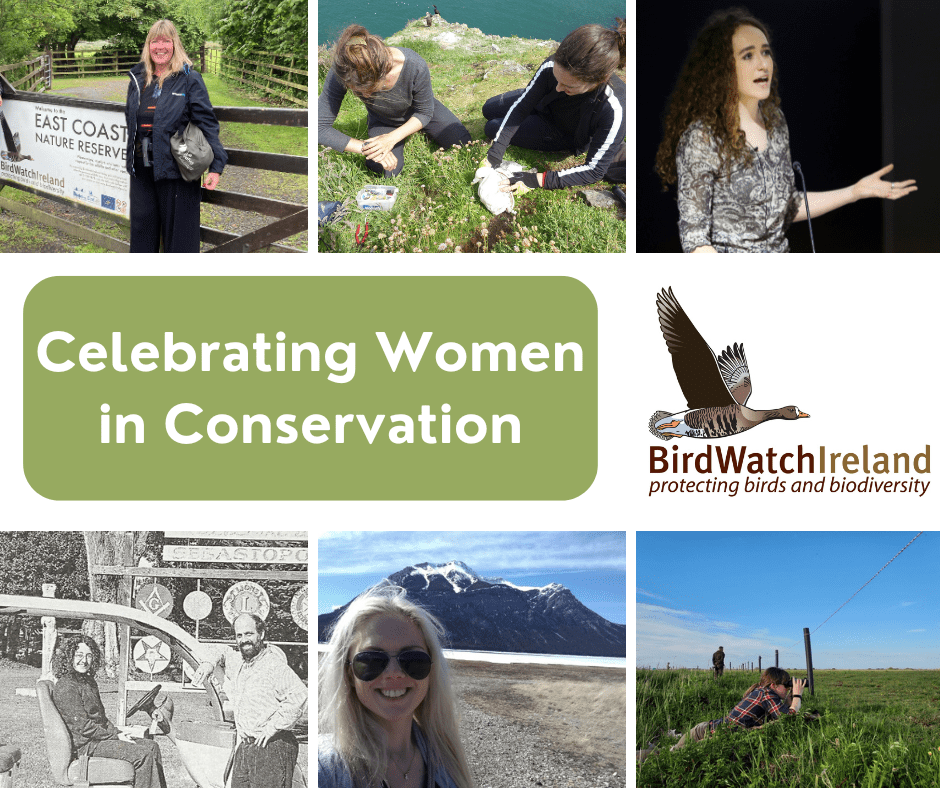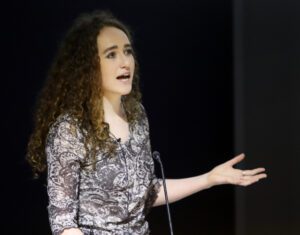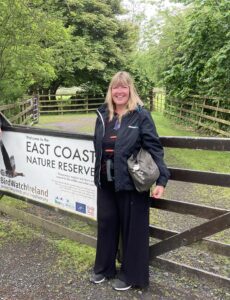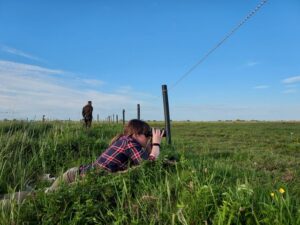
This International Women’s Day, we are celebrating some of the many women on the BirdWatch Ireland Team whose passion, dedication and expertise drive our mission to protect wild birds and their habitats. Here, they share some of their thoughts about being a woman in the conservation and environmental spaces.
Oonagh Duggan, Head of Advocacy with BirdWatch Ireland
Clipping from the Santa Maria Sun newspaper, April 2002.
Can you share a bit about your journey and what inspired you to work in conservation?
I’ve been working for our environment for almost 30 years. I don’t know when I began to notice nature, it was all around me on the farm I grew up on in Co Limerick. I do remember my aunt naming bird species for me. There were hares, skylarks, bird of prey like Kestrels and Sparrowhawks as well as flocks of Lapwing that would settle in the silage field. I always got a lot of peace up the fields. But it was years later in California that I figured out that there was a career in this area and it began a long, fun and sometimes torturous journey into the world of conservation.
Do you/ have you ever faced any specific challenges as a woman working in this field and if so, how do you overcome them?
I have not faced any challenges as a woman working in this field. Only once while working in an East Asian country did I see how women in that country were not given equal status as men. It was not me that was relegated but the female government officials of that country who were never at meetings. It was also so strange to be giving presentations to packed audiences and given important status yet the women who helped organise the conference were not invited to the social occasion at the end of the event. It was only men present. It sent a signal that sat very uneasily with me.
Can you tell us about a particularly memorable experience or success story from your work?
Two come to mind. The successful campaign with our BirdLife Europe partners and others to save the Birds and Habitats Directives from being ripped open and apart between 2015-2017 was memorable. We threw the kitchen sink at that campaign to save two of the best laws protecting nature in the world and it worked.
The other was when I worked with farmers in the central California coast near Guadalupe on water quality issues. The atmosphere was epitomised by the bumper stickers on some farmers’ trucks which said ‘Eat the salamander, save the broccoli’ which gives you a sense of the polarised environment. Protecting wildlife and addressing water quality declines were high on the agendas of regulators in this mostly intensive vegetable growing area. I was working on two projects with a local NGO to assist in restoring a lake and estuary ecosystem and especially to help address water quality issues. I literally cycled into the yards of the farmers and introduced myself. I think me being Irish helped and the fact that I lived in the area and got to know people. It was the best job of my life. I loved working with the farmers and we developed really good relations. So much so they would only trust me to take water quality samples on their land and not the consultants hired to do that work. The relationship building was as important as tackling the nitrates entering the water courses. It brought them to the table so we could discuss the issues at hand.
Do you have advice for women who wish to pursue a career in the conservation space?
Just go for it. Follow your heart. Take the opportunities that present themselves. If you’re not already working, volunteer if that opportunity is available, go on field trips, network, stay involved, stay on top of the developments in the field you are interested in. Never give up. And make sure you get enough enjoyment of nature in your life regularly to keep yourself going.
Do you have anything you wish to add?
I feel so lucky to have had the best career in nature conservation and broader environmental work. It can hit very hard to see the losses of wild birds and other biodiversity. But I am doing my best and that’s all I can do.
Rosalind Skillen, Marine Policy and Advocacy Officer with BirdWatch Ireland
Can you share a bit about your journey and what inspired you to work in conservation?
I got involved in the environmental sector through youth advocacy and volunteering with organisations, like Ulster Wildlife and Friends of the Earth. It’s the amazing people working in this sector that inspire me to keep going, as well as my desire to build a more sustainable and inclusive future for all. I also enjoy the collaborative nature of the environmental sector and I love working with different individuals and groups to achieve a shared goal. After all, it’s the literal ground beneath our feet that provides common ground.
Do you/ have you ever faced any specific challenges as a woman working in this field and if so, how do you overcome them?
Talking to my female friends and colleagues has helped me to overcome obstacles that I have faced. Sharing experiences with one another and creating a culture of openness and respect is very important.
Do you have advice for women who wish to pursue a career in the conservation space?
Think about what skills you have, and how they link to the environmental sector (because they do!) Conservation can be quite technical and scientific, and that can put people off, especially if they don’t come from an ecology background. But the conservation space needs people with all sorts of skills: communication skills, financial skills, campaigning skills. We need everyone on board and all hands on deck. Everyone has something to contribute!
Do you have anything you wish to add?
Volunteering for a local conservation charity is also a great way to gain further experience in the sector. It can help you to grow your skillset, expand your network, and learn more about future job opportunities.
Linda Lennon, CEO of BirdWatch Ireland
I decided to apply for the role at BWI as whilst my background is in public and private sector roles I have always had a deep interest in conservation and wanting to play a role in saving the planet.
I have invested in solar panels at home; put in a small wildlife pond and wildflower meadow in the garden of my suburban home and every day find pleasure in nature whether it be seeing water skaters or newts in the pond or watching the blue tits check out my nest boxes.
This role has enabled me to utilise so many of the skills acquired elsewhere and also to build on the experience I gained elsewhere where we had SSSI sites, over 1300 species of Lepidoptera and with one Park attracting over 200 different species of bird.
Success for me is seeing the amazing efforts of my team whether they are monitoring, surveying or ringing birds thus building up knowledge and scientific data to help us advocate for beneficial changes. All too often people regard birdwatching and associated roles as a male preserve but we have female scientists, conservation officers ; project managers; project officers and field workers as well as females in our advocacy, admin, finance and communication teams . Our Senior leadership team is evenly split between men and women, and we now also have two female Board members. I have never felt I have been disadvantaged or treated differently whilst in this role. Conversely people working in this conservation space seem to be supportive; engaging and willing to partner up for the common good of birds and nature.
Kathryn Finney, Curlew EIP Project Manager with BirdWatch Ireland
Can you share a bit about your journey and what inspired you to work in conservation?
I grew up on a farm in the Shannon Callows and was always out working with my Dad. He loved nature and the nature on his farm. My mother was a primary school teacher and loved teaching her students about nature. They passed this love of nature onto me. I loved agriculture and wanted to do something that incorporated both nature and agriculture. I originally wanted to be a full-time farmer, but that was not a common career path for girls in my day! I went to Aberdeen University in Scotland because it was the only course I could find that married agriculture, biodiversity, land use policy and sustainable development. I ended up with BirdWatch Ireland as somewhat of an accident. After many years away, I ended up back home on the family farm, broke and miserable after a year in Australia. When a job came up with BirdWatch, I went for it. I couldn’t believe that my ideal career was in my hometown! From my very first day, I loved the way Birdwatch respected the farmers they dealt with, and how committed they were to helping them find solutions to protect the biodiversity on their farms, both in practice and at a policy level. I was also privy to the thinking of farmers and knew from conversations around the kitchen table that the farmers felt respected and supported and this meant a lot to me. This type of relationship between conservationists and farmers might be commonplace now, but 20 years ago it was unique. This relationship still exists today.
Do you/ have you ever faced any specific challenges as a woman working in this field and if so, how do you overcome them?
As a woman, in a very male-dominated field it can sometimes be hard to be taken seriously and for your voice to be heard. This was especially true in the early days as being both a conservationist and a woman could be a double negative! I’ve been lucky though. Because I am from a farm and actively worked on it, and studied agricultural policy, I can talk the talk! Often this stands for itself, most especially with farmers.
I still sometimes find that questions or conversation is automatically directed at whichever male I am with instead, regardless of their role or area of expertise. I’ve been very lucky though to work with some wonderful men, who have not hesitated in redirecting questions! And I’m less bothered by it now, I let my work speak for itself.
Can you tell us about a particularly memorable experience or success story from your work?
I’ve worked with farmers to develop and trial agri-environmental measures for breeding waders for nearly 20 years. Together we have developed the schemes and measures in previous agri-environmental programmes, built the first predator-proof fence in the Republic of Ireland, carried out habitat restoration work and developed predator control initiatives. Working with my colleagues in BirdWatch Ireland and the EIP program at a policy level, we’ve seen that these are adopted by the national program. We have achieved a significant step in safeguarding breeding waders nationally.
Do you have advice for women who wish to pursue a career in the conservation space?
Go for it! The doors are open and it’s a wonderful career.
Helen Boland, Dublin Bay Birds Project Manager
Can you share a bit about your journey and what inspired you to work in conservation?
From childhood I noticed and appreciated nature, and especially loved being out in nature, still do. My grandfather was a big influence on me as he had a great appreciation and knowledge of nature and wildlife.
Do you/ have you ever faced any specific challenges as a woman working in this field and if so, how do you overcome them?
My own experience of working in conservation has been very positively influenced by all the amazing women I’ve had the pleasure to work with. In my time in BirdWatch Ireland, women have played leading roles in everything from scientific data analyses to trudging through soaking wet saltmarsh gathering field data in the middle of winter! There has always been a brilliant dynamic and working relationship between the male and female staff.
Can you tell us about a particularly memorable experience or success story from your work?
There have been many. And being part of projects with an overall mission to protect and conserve nature is wonderful. But in general, some of the most enjoyable experiences personally include lying in summer sunshine on cliff tops carrying out monitoring of seabird colonies. And in winter, walking the coastline of remote parts of Ireland looking for waterbirds has been very rewarding, as is observing enormous flocks of wintering waders of multiple species swirling around and jostling for space at a high-tide roost.
Do you have advice for women who wish to pursue a career in the conservation space?
Join a club or group that is linked with environmental activities! Take part as a volunteer in one of the surveys run by BirdWatch. Join your local BWI Branch. These are great ways of meeting people, of finding out what’s going on, and of learning how to survey birds and building up some experience.
Amy Lewis, Communications Officer with BirdWatch Ireland
Can you share a bit about your journey and what inspired you to work in conservation?
I’ve spent much of my career working in journalism and communications. However, I have had a deep curiosity and passion for nature from a very young age. I have very fond memories of peering curiously into rockpools during holidays in Kerry as a toddler and later on, of patiently standing by the local river with my Dad, hoping to catch the blue flash of a Kingfisher.
I know now that this time in nature doesn’t just spark my curiosity, it brings me solace unmatched by anything else. In times when I didn’t have easy access to green spaces or birdsong, I did what I could to recreate my experiences. For example, during a (particularly frantic!) period of my life living in a tiny studio apartment in Paris, I resorted to playing birdsong off YouTube to bring me the peace I so badly needed.
As I got further into my journalism career and my knowledge of the problems facing our planet grew, I knew that I wanted to do what I could to raise awareness. Our habitats and the wildlife within them don’t have a voice, at least not in the traditional sense, but they are sharing messages that we can translate and communicate. Recognising this, it made sense to marry two of my passions – writing/ storytelling and the natural world. I began to focus my writing on environmental issues where possible, first as a freelance while living in Vietnam and later as a staff reporter. When an opportunity to work in communications with BirdWatch Ireland arose in 2023, I went for it and I haven’t looked back.
Do you/ have you ever faced any specific challenges as a woman working in this field and if so, how do you overcome them?
In this particular field, I have been met with nothing but support and encouragement.
One of the biggest challenges I face is not necessarily connected to being a woman, though I am sure many women can relate to it. I am quite empathic, and care and feel a LOT! On one hand, leaning into this sensitivity allows me to be creative, to connect, to experience the richness of our natural world. On the other, witnessing issues such as the climate crisis and biodiversity loss can be viscerally painful.
I don’t think there is anyone who works in the conservation space who doesn’t care deeply, so I am sure many can understand this challenge. I have learned that self-care – which for me looks like reading, creative writing, running/ yoga and of course, spending time outside – is extremely vital, as is sharing these feelings and leaning on support networks. The more we support one another and work together, the stronger we can be and the greater our impact can be.
Can you tell us about a particularly memorable experience or success story from your work?
I still am relatively new to the BirdWatch Ireland team but one recent experience that stands out to me is working on the Save the Skydancer campaign together with colleagues in BWI, An Taisce and the Environmental Pillar. It was a campaign that brought together science, photography, human experience and even poetry, all with the aim of getting the public behind our calls for a stronger and more ambitious Hen Harrier Threat Response Plan. It really seemed to capture people’s hearts and minds and illustrated for me just how great an impact we can have when we pool our strengths and work together. We have yet to understand the full impact of our campaign but I know that it was as strong as it could be.
Another relevant experience that stands out to me from my journalistic days is accompanying the late Mark Stanley of the Wexford Barn Owl Project to ring Barn Owl chicks in south Wexford. Witnessing these incredible creatures up close was an unforgettable experience and Mark’s passion for Barn Owls and indeed, nature in general, was both inspiring and infectious.
Do you have advice for women who wish to pursue a career in the conservation space?
You don’t need to be an expert or the loudest person in the room to make a difference. There is a place for everyone in this field. Simply being a human on this planet who is part of this interconnected web of things gives you something to offer. So, harness your own personal strengths, experiences and passions and see where that leads you. Also, don’t be afraid to ask questions along the way! We can all learn from one another.






